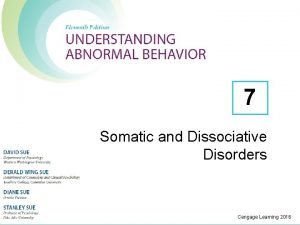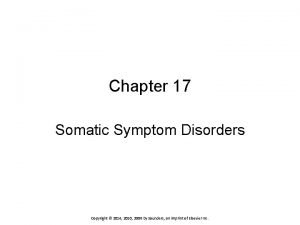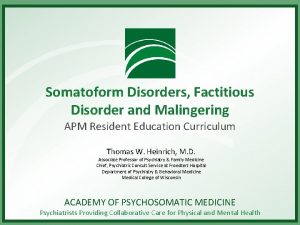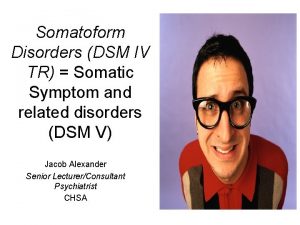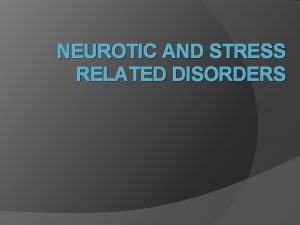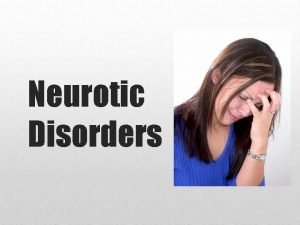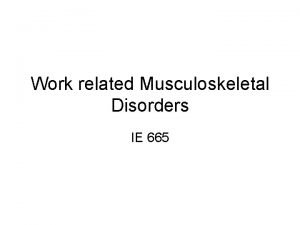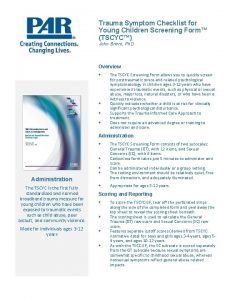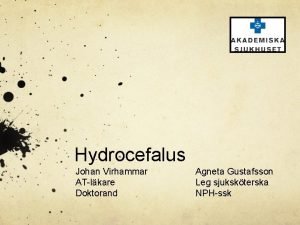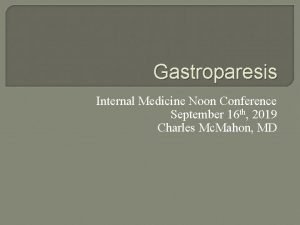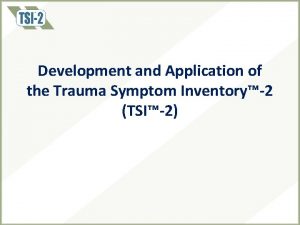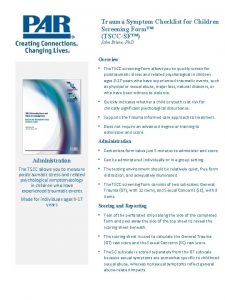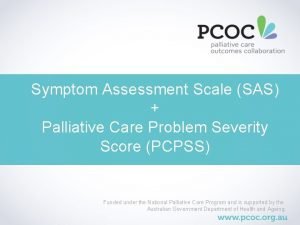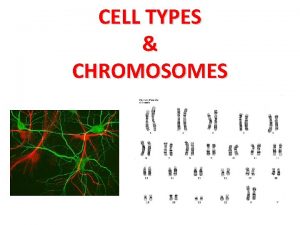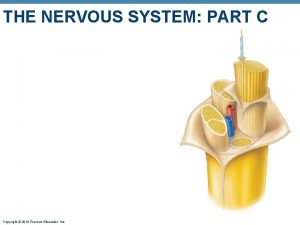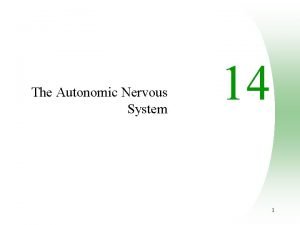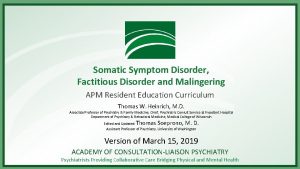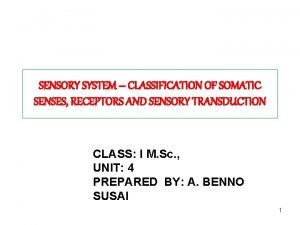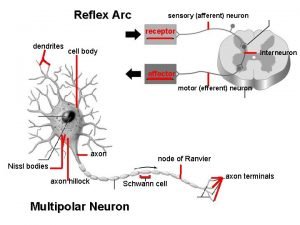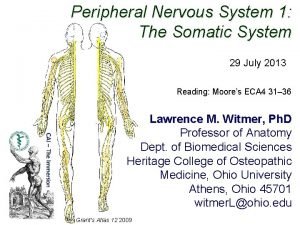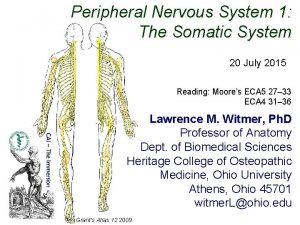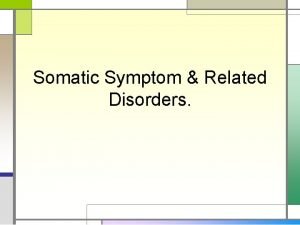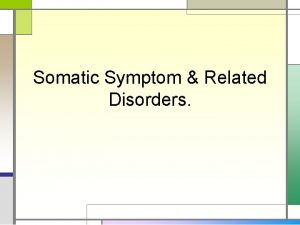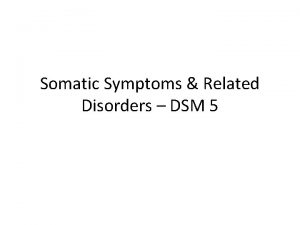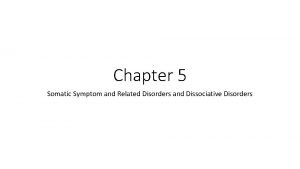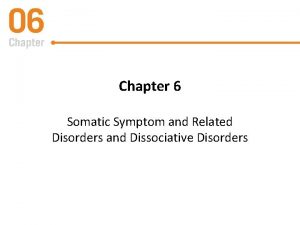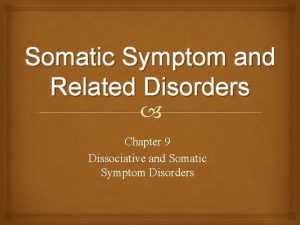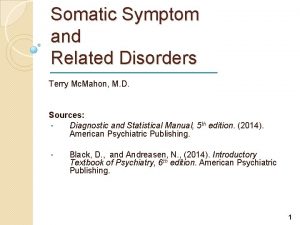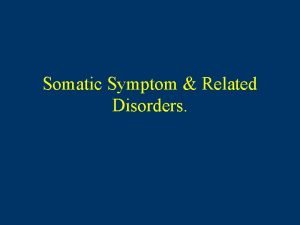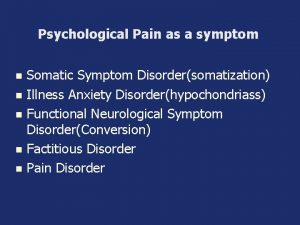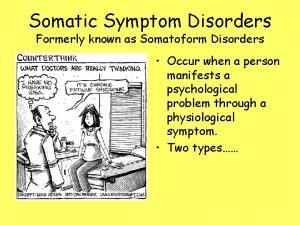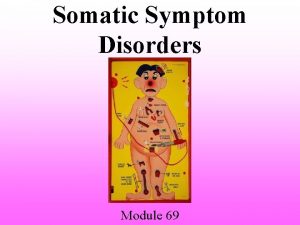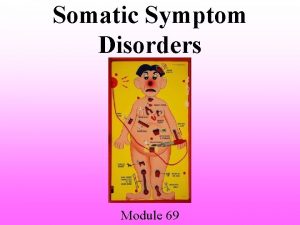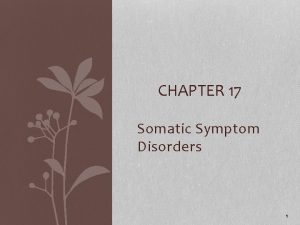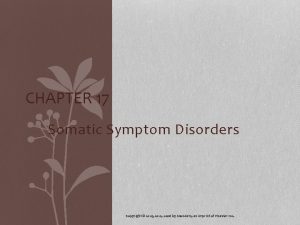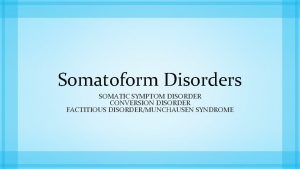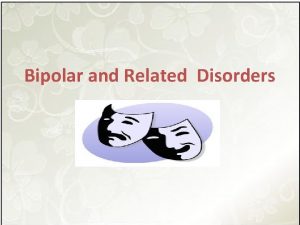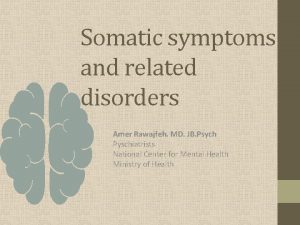Clinical Cases with Somatic Symptom and Related Disorders


















































- Slides: 50

Clinical Cases with Somatic Symptom and Related Disorders Yasin Ibrahim, MD Assistant Professor of Psychiatry Texas Tech University Health Sciences Center

Case 1: chronic pain • Michelle Adams, a 51 -year-old a hair dresser, with no prior psych hx who was referred from her PMD for psych evaluation. She has been suffering from severe back pain resulted from a trauma 13 months ago. • She fell from the fire escape and fractured her pelvis, coccyx, right elbow, and three ribs. • After the trauma, she was bedridden for 6 weeks and then underwent several months of physical therapy. Daily narcotic medication was only moderately helpful. She had seen “a dozen” doctors in various specialties and tried multiple treatments, including anesthetic injections and bioelectric stimulation therapy, but her pain was unrelenting.

• Lately, she let the calls (from her friends) go to voice mail most of the time because she just did not feel up to socializing on account of the pain. • She had been unable to return to work since her accident on account of the pain. • “These doctors keep telling me I’m good to go back to work, ” she said with visible anger, “but they don’t know what I’m going through. ” • In the last month, she had stopped bathing daily and gotten slack about cleaning her apartment. She reported sad mood, and felt hopeless.

• What is the most likely diagnosis/diagnoses? • • Major Depressive Disorder Opioid use disorder Somatic Symptom Disorder Factitious Disorder

Diagnosis • SSD, with predominant pain, moderate to severe, • MDD

Discussion • She has received care, rehabilitation, various invasive outpatient procedures, and even opioids yet her pain persists. • Distress (depression), excessive thoughts and dysfunction escalates (not able to work, or take care of herself) • Avoid confrontation over opioids and focus more on treating depression

Diagnosis of SSD • One or more somatic symptoms that are distressing or disruptive to daily life • Excessive thoughts, feelings, or behaviors related to somatic symptoms or health concerns as evidenced by one or more 1. Disproportionate and persistent thoughts about the seriousness of symptoms 2. Persistently high level of anxiety about health or symptoms 3. Excessive time and energy devoted to these symptoms or health concerns

Differential Diagnosis of SSD Features suggesting somatic symptom disorder over a medical condition – Multiple organ systems involved – Early onset, chronic course, no physical signs – Absence of lab abnormalities – History of extensive tests – Presence of a psychiatric disorder Additional mental disorders to rule out: Somatic delusion, OCD, Anxiety, Depression, and Substance use disorders

Treatment of SSD – Care not cure – Long-term relationship with empathic primary care physician – Physician training to provide psychosocial interventions and avoid unnecessary medical care that can lead to iatrogenic complications – Cognitive behavioral therapy – Antidepressants or anxiolytics to treat comorbid depression and anxiety and, possibly to decrease somatic preoccupatio

Case 2. Somatic Complaints • Norma Balaban, a 37 -year-old married woman was referred by her primary care physician for evaluation of depression and multiple somatic symptoms. • Her problem list included • nocturnal leg spasms • sleep difficulties that led to head heaviness. • intermittent cold sensations in her extremities, face. • Pulsating sensations in her eyes after a poor night’s sleep. • difficulty urinating, menstrual irregularity • right gluteal pain • neck stiffness

• Patient has been seen by a rheumatologist who diagnosed her with mechanical back pain without evidence of inflammatory arthritis. • A neurologist diagnosed her with atypical migraine variant. • Tests performed (all were normal): two electroencephalograms, an electromyogram, three brain and three spinal magnetic resonance images, two lumbar puncture studies, and serial laboratory exams.

• She spoke to the psychiatrist primarily about her physical complaints. • She found it difficult to concentrate and complete her work and was spending a lot of time on the Internet researching her symptoms. • She acknowledged bouts of depressed mood over the prior year with some anhedonia and occasional thoughts of suicide. • She had started taking fluoxetine and gabapentin, prescribed by her primary care physician, and experienced partial improvement in her mood and some of her pains.

• What is the most likely diagnosis/diagnoses? • • Major Depressive Disorder Somatic Symptom Disorder Factitious Disorder Illness Anxiety Disorder

Diagnosis • SSD • Depressive disorder.

Discussion • Large number of seemingly unrelated physical symptoms. • An inordinate amount of time and energy devoted to thinking about and seeking care for her somatic symptoms. • Some depressive symptoms including SI.

Case III: Chronic Lyme Disease • Oscar Capek, a 43 -year-old man, was brought by his wife to an emergency room (ER) for what he described as a relapse of his chronic Lyme disease. he had been fatigued for a month and bedridden for a week. Saying he was too tired and asked the ER team to call his psychiatrist (for two decades) • The psychiatrist reported that he first saw Mr. Capek for panic attacks which resolved quickly, but Mr. Capek continued to see him for help coping with his chronic illness (lyme disease). • Initially a graduate student pursuing a master’s degree in accounting, Mr. Capek dropped out of school over worries that the demands of his studies would exacerbate his disease.

• Capek usually felt physically and emotionally well. He deemed that his occasional fatigue, anxiety, and concentration difficulties were “controllable” and did not require treatment. • He would often bring in articles on chronic Lyme disease for discussion and was active in a local Lyme disease support group. • Mr. Capek’s symptoms would occasionally worsen. This occurred less than yearly, and these “exacerbations” usually related to some obvious stress.

• All testing for Lyme disease thus far had been negative. When the internist explained this, Mr. Capek became defensive and produced literature on the inaccuracy of Lyme disease testing. • A standard laboratory screen was normal with the exception of a slightly low hemoglobin value. On hearing about the low hemoglobin, Mr. Capek became alarmed, dismissed reassurances, and insisted this be investigated further.

• What is the most likely diagnosis/diagnoses? • • Major Depressive Disorder Somatic Symptom Disorder Factitious Disorder Illness Anxiety Disorder

Diagnosis • Illness anxiety disorder, care-seeking type

Discussion • Mr. Capek insists that he has a disabling disease despite more plausible explanations. His insistence is undeterred by negative testing and contributes to chronic health anxieties and poor functioning. • IAD fits him more because the symptoms are mild. His behavior toward the likely insignificant hemoglobin test demonstrates his hypersensitivity toward any indication of worsening health.

• It is important, still, to rule out a yetundiscovered medical illness (fibromyalgia, chronic fatigue syndrome) • Also rule out: - Psychotic delusion: Rigid, implausible, other psychotic symptoms. - OCD: more related to contamination,

Illness Anxiety Disorder Diagnosis • Preoccupation with having a serious illness • Performance of excessive health-related behaviors OR maladaptive avoidance (e. g. , avoiding doctors or hospitals) • Somatic symptoms are not present or are mild – If a medical condition is present, concerns are excessive • Causes distress or impairment

DD of Illness Anxiety Disordwer • Somatic symptom disorder • Panic disorder • Generalized anxiety disorder • Obsessive compulsive disorder • Body dysmorphic disorder • Delusional disorder, somatic type

Treatment of IAD • Psychotherapy: CBT – Anxiety primarily relates to the meaning, significance, cause, and consequences of non-pathological physical signs or sensations – Cognitive restructuring and exposure to interoceptive sensations • Medications: serotonergic antidepressants • Medical management – Maintain contact with caring physician – Minimize medical work-ups

Case 4. Seizures • Paulina Davis, a 32 y/o female with history of epilepsy and no known psychiatric history, who was admitted for seizure. • After failed trials of Lorazepam, the siezures responded to fosphenytoin dose. • Labs showed normal levels of her antiepileptic and negative urine toxicology. • (EEG) was ordered. Shortly after the study began, Ms. Davis began convulsing; this prompted administration of intravenous lorazepam. When the EEG was reviewed, no epileptiform activity was identified.

• She was placed on video-EEG (v. EEG) monitoring during which she had several episodes of convulsive motor activity; none were associated with epileptiform activity on the EEG. • Psychiatry was consulted and Ms. Davis denied prior psychiatric evaluations or symptoms. • She only was concerned about the impact that her seizures might have on her long-term health

• When the findings of the v. EEG study were discussed with Ms. Davis, she quickly became quite irritable, asking, “So, everyone thinks I’m just making this up? ” • Ms. Davis pulled her EEG leads from her scalp, dressed herself, and left the hospital against medical advice.

• What is the most likely diagnosis/diagnoses? • • Somatic Symptom Disorder Factitious Disorder Conversion Disorder Illness Anxiety Disorder

Diagnosis • Conversion disorder (functional neurological symptom disorder) with seizures, chronic

Discussion • She complains of altered sensory or motor function that cannot be accounted for by a recognized medical or condition. • be aware of the common co-occurring findings of depression, chronic pain disorders, fatigue, and a history of abuse. • Patients can have NES comorbid with epilepsy (in 10%) • Although patients may become angry upon learning of a diagnosis of conversion disorder, the focus of discussion should be on the good news: that they will not be exposed to unnecessary medication or studies, and that treatment —in the form of psychotherapy—is available.

Diagnosis of Conversion Disorder • One or more symptoms of altered motor or sensory function • Clinical findings of incompatibility between symptoms and recognized neurological or medical conditions • Causes distress or impairment, or warrants medical evaluation

DD of Conversion Disorder • • • Multiple sclerosis: blindness resulting from optic neuritis Myasthenia gravis: muscle weakness Periodic paralysis: muscle weakness Myopathies: muscle weakness Polymyositis: muscle weakness Guillain-Barre syndrome: motor and sensory Symptoms Remember “Drop test” and Hoover’s sign

Diagnostic Specifiers: Symptom Types – With weakness or paralysis – With abnormal movement: tremor, dystonia, myoclonus, gait disturbance – With swallow symptoms – With speech symptoms: dysphonia, slurring – With attacks or seizures – With anesthesia or sensory loss – With special sensory symptom: visual, olfactory, or hearing deficits – With mixed symptoms

Treatment of Conversion Disorder Acute treatment – Do not confront with psychological underpinnings – Suggestion therapy: “you’ll notice yourself getting better; it may take up to a few hours” Ongoing treatment: CBT • Address stressors that overwhelmed patient • Cognitive restructuring, stress management, coping skill training • Caution: do not miss medical diagnoses • Neurologic comorbidities are common

Case 5. Abdominal Pain • Psychiatrist was called to assess possible depression in Rebecca Ehrlich, a 24 -year-old woman who had been hospitalized for severe abdominal pain that induced by her underlying Crohn’s disease. • She has history of anxiety which was treated with psychotherapy. She studied psychology and worked as nurse assistant. She has an aunt with Crohn’s disease. • She stated the recurrent abdominal pain had wrecked her social life and her job prospects. She had lost a job the year before because of Crohn’s flares. • As a member of an online bowel disorders support group, Ms. Ehrlich e-mailed other members on a daily basis.

• The primary medical team was having difficulty obtaining collateral information from previous physicians whose name the patient could only spell phonetically. • She could not explain why the team was unable to locate her doctor and became irritated when the medical student pressed more specifically to elicit further details about her prior care. • The mother was called and stated that she did not know the exact names or phone numbers of her daughter’s medical providers. • She stated that Ehrlich had been hospitalized at least six times, in contrast with the daughter’s report of two earlier hospitalizations. Neither the gastrointestinal (GI) team nor the medical student was able to locate Ms. Ehrlich’s primary gastroenterologist

• She appeared calm and unworried about her upcoming procedures. • She looked sad at the beginning of the interview, but she appeared more engaged and euthymic the more she talked. • Ms. Ehrlich’s endoscopy and colonoscopy results were normal. The GI team told her that she could be discharged the next morning and that she should have her internist call them. She readily agreed. • Ms. Ehrlich told the student that she was “feeling better already. ” She quickly removed her own intravenous line and started to get dressed. The student went to get the primary GI team. When they returned, the patient was gone. • The next day, one of the patient’s providers was called reported that patient had a prior admission that was strikingly similar: after a short hospitalization, she quickly fled from the hospital after a normal colonoscopy.

• What is the most likely diagnosis/diagnoses? • • Somatic Symptom Disorder Factitious Disorder Conversion Disorder Illness Anxiety Disorder

Diagnosis • Factitious disorder, recurrent

Discussion • she presents herself as ill by falsifying symptoms; there are no obvious rewards to the hospitalization; and there is not an obvious alternative diagnosis such as a psychotic disorder. • Ehrlich’s inability to verify specific past providers. • a recurrent pattern of dishonesty. • Having a family member with Crohn’s disease. • patients may have elements of multiple disorders. For example, Ms. Ehrlich might have been subconsciously motivated by taking on the sick role but might also have enjoyed the ready access to intravenous opiates.

• Patients with factitious disorder may claim depression, for example, following the death of a loved one who has not died. They may add blood to a urine sample, ingest insulin or warfarin, or claim to have had a seizure. • It is important to remember that patients with factitious disorder are quite ill, but not in the way they pretend.

Case 6 Breathlessness • Sophie Fredholm was a 26 -year-old woman with cystic fibrosis (CF) who was brought to the hospital with symptoms of respiratory distress. • On day 4, psychiatry was consulted because The patient was refusing to wear the bivalve positive air pressure (Bi. PAP) device and was consistently found to be hypoxic and hypercarbic. • The patient told the psychiatrist that she could not tolerate the Bi. PAP device because it made her claustrophobic. She did not feel that the Bi. PAP device was as necessary as the doctors were saying. • She complained that the doctors and nurses were not coming to see her frequently enough.

• As a child, her mother, a school nurse, had administered her treatments. When the patient became an adolescent, she would frequently refuse the treatments and tell her parents she wanted to be “out like a normal kid, ” • She was continuously adjusting her oxygen face mask, taking it off for a few minutes, and then stopping to say she was too short of breath to continue talking. She repeatedly glanced through the open door of her room, and wondered aloud when her mother would be getting back from lunch in the cafeteria. . She and her mother, she said, knew how to manage her symptoms better than the doctors did. • Later that night, because of rising carbon dioxide levels, Ms. Fredholm was intubated.

• What is the most likely diagnosis/diagnoses? • • Somatic Symptom Disorder Factitious Disorder Conversion Disorder Psychological factors affecting other medical conditions

Diagnosis • Psychological factors affecting other medical conditions

Discussion • In refusing elements of her treatment (i. e. , Bi. PAP), Ms. Fredholm impedes optimal management and perhaps contributes to a negative outcome (intubation). • Her behavior seems to be related to primary affect states (anxiety) as well as emotionally laden beliefs (that others cannot know her body’s needs as well as she and her mother do; that she has been abandoned. • Many psychiatric conditions—ranging from the substance use disorders to the psychotic, mood, and anxiety disorders—are associated with behaviors that can worsen a comorbid medical condition. In such cases, the other psychiatric condition should generally be noted rather than PFAOMC.

Take Home Tips • For SSD, focus more on addressing the distress and dysfunction rather than the detection of falsehood of the medical symptoms. • For Conversion disorder look for incompatibility between the symptom and recognized neurological or medical conditions. • Patients can have both of medical illness and SSD at the same time. • Don’t rush to an SSD diagnosis, because once the patient’s symptoms are attributed to a psychiatric diagnosis, the medical workup tends to cease. (e. g appendicitis)

• Questions?

• Thank You
 Somatic symptom and related disorders
Somatic symptom and related disorders Types of somatic disorder
Types of somatic disorder Chapter 17 somatic symptom disorders
Chapter 17 somatic symptom disorders Dsm 5 munchausen by proxy
Dsm 5 munchausen by proxy Somatic symptom disorder
Somatic symptom disorder Factitious disorder
Factitious disorder Somatic symptom
Somatic symptom Bipolar and other related disorders
Bipolar and other related disorders Bipolar and other related disorders
Bipolar and other related disorders Neurotic, stress-related and somatoform disorders
Neurotic, stress-related and somatoform disorders Neurosis disorder
Neurosis disorder Criminal cases vs civil cases
Criminal cases vs civil cases Work related musculoskeletal disorders definition
Work related musculoskeletal disorders definition Physical fitness two types
Physical fitness two types Skills related
Skills related Trauma symptom checklist for young children
Trauma symptom checklist for young children Sekundr
Sekundr Ryggmärgsvätska läckage symptom
Ryggmärgsvätska läckage symptom Gastroparesis cardinal symptom index calculator
Gastroparesis cardinal symptom index calculator Trauma symptom inventory tsi
Trauma symptom inventory tsi Esasr
Esasr Esas skala
Esas skala Bullerskada symptom
Bullerskada symptom Pqrst symptom analysis
Pqrst symptom analysis Tscc score sheet
Tscc score sheet Sas palliative care
Sas palliative care Period symptoms
Period symptoms Gingivacancer
Gingivacancer Transmittorämnen
Transmittorämnen Thermoreceptors
Thermoreceptors What is the difference between somatic and gamete cells
What is the difference between somatic and gamete cells Distinguish between general senses and special senses.
Distinguish between general senses and special senses. Sympathetic nervous systems
Sympathetic nervous systems Ans
Ans Forensics pathology definition
Forensics pathology definition Somatic and special senses
Somatic and special senses Puppies, pigs, and people: eating meat and marginal cases
Puppies, pigs, and people: eating meat and marginal cases Site of somatic motor neuron cell bodies
Site of somatic motor neuron cell bodies Sympathetic
Sympathetic What are somatic complaints
What are somatic complaints Sns pg
Sns pg Somatic motor neuron
Somatic motor neuron Types of sensory receptors
Types of sensory receptors Haploid vs diploid venn diagram
Haploid vs diploid venn diagram Ideas of reference
Ideas of reference Rib raising omt
Rib raising omt Site of somatic motor neuron cell bodies
Site of somatic motor neuron cell bodies Rib somatic dysfunction
Rib somatic dysfunction Visceral afferent vs efferent
Visceral afferent vs efferent Klumpke palsy
Klumpke palsy Somatic hybridization diagram
Somatic hybridization diagram
